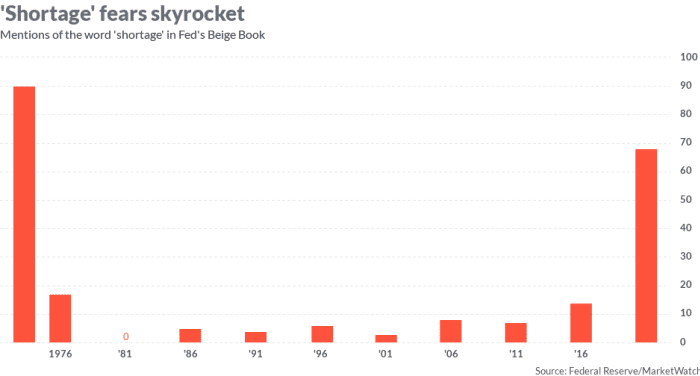This post was originally published on this site
It would be a great few days to be a fly on the wall at the Federal Open Market Committee meeting.
Even were it normal times, there’s the scandal of regional Fed presidents engaging in stock-market trading, which at least one outside group has said was possibly illegal. But it’s not normal times.
A key issue is the fate of its bond purchase program. A slightly out-of-consensus call comes from Drew Matus, chief market strategist at MetLife Investment Management, who says the Fed will wait until the beginning of next year to start reducing its bond purchases. “They’re trying to find the perfect time to do something that people might not react kindly to, and you probably don’t want to upset the holidays for people,” he says.
There’s also the situation at property developer China Evergrande
3333,
which has captured media headlines this week as it struggles to pay off creditors. Matus doesn’t expect China to be mentioned in the FOMC statement, and possibly not even the minutes. “Once they get to the point where they don’t think that there’s any sort of systemic risks to the U.S., and financial markets are functioning, that’ll be the end of the conversation, and they will migrate onto other things,” he says.
The big issue confronting the Fed is that demand has recovered more quickly than supply, creating all sorts of shortages as companies struggle to find the necessary workers and parts. “The more widespread shortages are, and the more that we talk about different products being in short supply, the more likely it is that a growing proportion of the consumer class is seeing their expectations for inflation de-anchor,” he says.

Matus says these shortages threaten the economic cycle. “It’s a race between how much do companies have to pay for things, and how much of that can they pass on to consumers,” he says. If corporate profit margins contract sharply, that would increase the chances of a recession, he says. The word “shortage” has received the most mentions in the Federal Reserve’s Beige Book of economic anecdotes since 1973, during the OPEC oil embargo. “If you think of 1973, the U.S. economy wasn’t really functioning all that well then,” he says.
He says he’s perplexed why bond yields remain so low. “When you’re looking at a 10-year note
TMUBMUSD10Y,
in the U.S., you’re looking not just at inflation next year, you’re trying to estimate where inflation is going to be over the next 10 years. And so even if inflation moderates from current levels, you would expect inflation would probably average over a 10 year period much higher than the current yield is,” he says, adding he doesn’t think real yields should be negative. The 10-year TIPS yielded -0.98% on Tuesday.
What could be happening is that investors are seeking a flight to quality, he says, though that doesn’t neatly fit with stock markets near records, and other assets surging. “You have to put the money somewhere,” he replies.
Matus says investors are in an unusual position where they can’t measure critical factors like the duration of the pandemic or how it will spread. “I think for a lot of investors, it defaults to basically, ‘do I want to be in the market or do I want to be out in the market, am I risk on or am I risk off?’ And I think that’s the behavior that you’re seeing in financial markets today.”
Market focus on the Fed dot plot
The Federal Reserve decision comes at 2 p.m. Eastern, and Chair Jerome Powell’s press conference is at 2:30 p.m. Key to the market reaction will be the dot plot of interest-rate forecasts. “Today’s dotplot likely will show more dots for a rate hike in 2022, but it’s not clear that progress since the June meeting has been enough to push three more FOMC members — making a majority — into expecting action next year,” said Ian Shepherdson, chief economist at Pantheon Macroeconomics.
The onshore subsidiary of China Evergrande said it has resolved the issue of its coming debt payment, as the fate of a dollar-denominated bond remains in doubt. A report said Evergrande could be restructured into three separate entities that would involve state ownership.
An example of the margin pressure Matus discussed came as shipping and logistics giant FedEx
FDX,
lowered its outlook for the year, citing supply-chain disruptions and a tight labor market.
Adobe
ADBE,
beat Wall Street estimates, though the software maker’s stock still saw pressure.
The Justice Department is investigating Zoom Video Communication’s
ZM,
deal to buy Five9
FIVN,
for $15 billion over China ties, according to a letter posted on the Federal Communications Commission website.
Restaurant payments company Toast
TOST,
is due to start trading, after pricing its initial public offering at $40 per share, significantly above the expected range to garner a $20 billion valuation.
Netflix
NFLX,
agreed to buy the Roald Dahl Story Co., adding popular children’s stories to its stable — and the ability to make not just films and television shows but also games and live theater.
The market
After the 10th drop in 12 sessions for the S&P 500
SPX,
on Tuesday, stock futures
ES00,
NQ00,
were pointing solidly higher.
The yield on the 10-year Treasury
TMUBMUSD10Y,
was 1.33%.
Random reads
Conor McGregor is a better fighter than pitcher.
A mountain goat is a better fighter than a grizzly bear, at least this one time.
Need to Know starts early and is updated until the opening bell, but sign up here to get it delivered once to your email box. The emailed version will be sent out at about 7:30 a.m. Eastern.
Want more for the day ahead? Sign up for The Barron’s Daily, a morning briefing for investors, including exclusive commentary from Barron’s and MarketWatch writers

